views
Preparing the House For Painting
Choose the right time of year. It's important to take the time of year into account when painting the exterior of your home, as very cold (below 40 degrees F) or very hot temperatures can ruin your paint job. Therefore, the best time to paint your house is in late spring or early autumn. Also remember to check the weather forecast to make sure there is no rain promised for the days you choose to paint.

Clean the surface of the house. If you're lucky, the only real preparation you'll need to do before the paint job is to clean the surface of your house. Use a hose to wash down the walls and go over any stubborn dirt with a wire brush and some warm soapy water. Alternatively, a power washer can be used to clean particularly stubborn dirt and remove paint flecks. Just be careful not to cause any damage to the home by setting the spray too high. Remember to wash from top to bottom, and allow the surface adequate time to dry thoroughly before proceeding with the paint job.
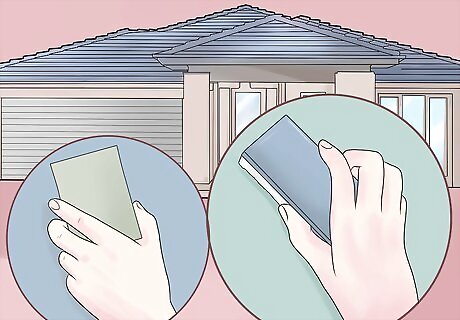
Remove any defective paint. If there is any old, defective paint on the surface of your house, you will need to remove it before you can proceed. This includes any paint that is loose, blistered or chipped. Failing to remove the old, chipped paint before you begin will prevent the fresh paint from properly adhering to the surface of the house. Use a wire brush or paint scraper to knock any loose paint free from the surface of the house and use a power sander (or a piece of sandpaper wrapped around a wooden block) to smooth any rough surfaces. If there are any heavy deposits of old paint that need to be removed, you may need to use an electric paint remover, which essentially melts the paint and then pulls it from the wall.

Make any necessary repairs. Before you begin painting, you will also need to inspect your house for damage and make any necessary repairs. It may seem like an effort, but it will ensure that your house looks its best once the paint job is complete. Walk around the periphery of the house and look for split shingles and siding, rust, mildew, popped nails. Don't just look at the exterior walls, also examine under the eaves and around the foundation. Pay attention to areas around windows and doors where old caulk or putty may be missing or needing replacement. Any rust will need to be removed and mildew will need to be scrubbed away. Cracked siding will need to be filled and sanded, loose caulking or split shingles will have to be replaced and leaky gutters and downspouts will need to be repaired.

Figure out how much paint you're going to need. It's a good idea to figure out how much paint you're going to need before you begin painting. This eliminates the risk of running out of paint halfway through. To estimate the amount of paint you'll need, measure the perimeter of the house and the height of the house (excluding any gable ends) and multiply them by each other. Divide this number by the square foot coverage indicated on the can of paint you plan to use. This will give you the quantity of paint (in gallons) you will need for a single coat. However, it is a good idea to add an extra gallon to that number for safety. To calculate the amount of extra paint needed for any gable ends, measure the width and height of the gable end, multiply these numbers, then divide by 2. This will give you the gable's square-foot dimensions, which you can then include in your paint estimations. Keep in mind that certain exterior wall surfaces - such as shingles, masonry and stucco - may need 10% to 15% more paint than smooth, flat walls with the same square footage. The application method may also affect the type of paint you need - airless sprayers may require up to twice as much paint (for the same wall dimensions) as brushes or rollers.

Prime the surface. In some circumstances, you will need to apply a coat of primer to the surface of your house before you can begin painting. Primer provides a good foundation for the paint and will help it to last longer, as it provides extra protection from the elements. You will need to apply primer to certain distressed areas of the house, especially if your prep work exposed any raw wood or bare metal, or if you scraped away a lot of loose paint. You will also need to apply primer if you are painting new wood for the first time, or if you are drastically changing the color of your home. The type of primer you use will depend on the type of paint. If you plan on using latex paint, you will need latex primer. If you plan on using solvent-thinned paint, you will need a solvent-base primer, and if you use metal paint, you will need a metal primer.

Choose your paint. Choose a high quality exterior paint, such as 100 percent acrylic latex. This will produce a better color, dry faster and be more durable in the long run. Look for paint with a higher percentage of volume solids, and opt for cans labelled "premium" or "super-premium" rather than choosing budget brands. Make sure you choose paint specifically meant for exteriors since it will hold up better than interior paint. Also put some thought into the color you choose for your house. Take the style of your home into account and make sure the paint color complements the roof material and any brick or stone accents. Consider getting samples of your top colors and painting swathes on an obscured portion of your home. Take a couple of days to see how each of the samples look in different lights and decide which ones you prefer.

Mix your paint. If you bought several cans of paint, you will need to mix all of the paint from individual cans together in one large container. This is due to the fact that the color of different batches of paint can vary slightly, even if it's meant to be the same. Mixing them together ensures an even color. Hold on to the original paint cans though. That way, if you have any paint left over you can pour it back into the original cans and reseal it. At this point you should also cover the area around your home with drop cloths, to prevent any paint from getting on sidewalks or landscaping.
Painting the House
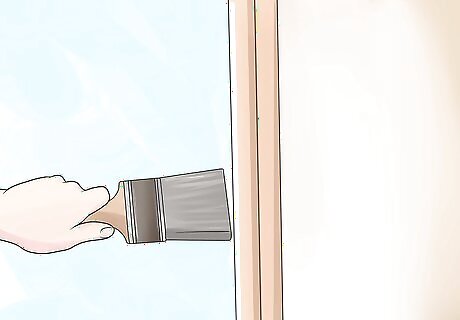
Decide which paint application method to use. Whether you use a brush, roller or paint sprayer to paint your house is ultimately a matter of personal preference. Each method has its benefits - using a brush gives you greater control over the painting, using a roller makes the job more efficient, and using a paint sprayer provide heavier coverage. Using a brush: Many people who are painting their homes for the first time prefer to use a brush, as it forces you to be very thorough and gives you control over every square inch of the house. To use: dip your brush into the paint until the bristles are halfway covered. Touch the brush against the wall at several points across a horizontal line. Go back and paint back and forth to fill in the empty spots and provide even coverage. Using a Roller: To use a roller, roll it in the paint until all sides are evenly covered, then apply the paint to the wall using criss-cross strokes. Then, go back and paint over the same section using up and down strokes to fill in the gaps. Using a paint sprayer: To use a paint sprayer, load your chosen paint into the sprayer. Hold the sprayer upright, about 1 foot (0.3 m) away from the wall. Move the sprayer smoothly back and forth, beginning the motion prior to pulling the trigger to avoid areas of heavy deposits of paint. Make sure each new stroke overlaps the previous one by about 8 inches (20.3 cm). Using the spray and back-roll technique: The spray and back-rolling technique is a particular method recommended for both its speed and evenness of coverage, but it requires two people. It involves one person using a sprayer to quickly coat the wall in paint, and the other person following behind with a roller to spread and even it.
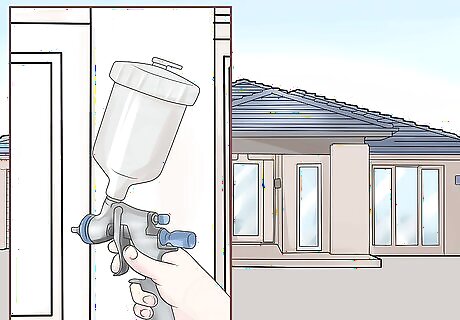
Paint the sidings. Paint all of the sidings on your house before you work on the trim. This gets the bulk of the work out of the way, and also speeds up the process as you won't need to switch between colors. When painting your sidings (or whatever material covers the main exterior of your home) there are several rules you should adhere to: Work from top to bottom. Always work from top to bottom and from left to right when painting. Working from top to bottom allows you to cover up any drips of paint that fall as you work your way down, while going from left to right helps you to quickly identify any spots you might have missed (this is related to the fact that you read from left to right, so your brain is programmed to process information better this way). Follow the sun. Try to plan your paint job so you are following the sun throughout the day, waiting until the morning sun has dried any night-time moisture from the walls. You want to work in the shade throughout the day, away from direct sunlight, as this can affect the quality of the final result. Be careful using a ladder. It is important to be very careful when using ladders, especially extendable ones. You should never reach more than an arm's length away when standing on a ladder. Instead, you should paint in a horizontal strip as far as you can reach, then move the ladder across to continue painting along the same line. Make sure that your ladder doesn't tilt from side to side, and that it's resting on even ground about 1/4 of its total length away from the foundation of the house.
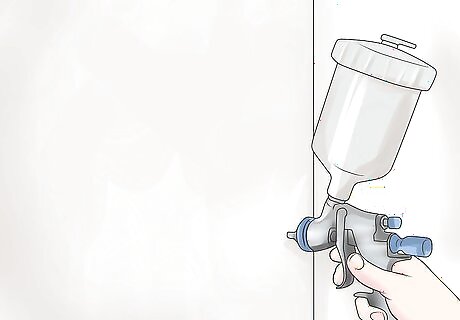
Apply a second coat. Once you have waited the recommended amount of time for the paint to dry, you should consider applying a second coat - if time and budget allows. A second coat will even out the paint and provide more protective coverage for your home. It will help the finished product to look better and last longer. If you have chosen a more vibrant color for your home, a second coat will often be necessary to really bring life to the color.
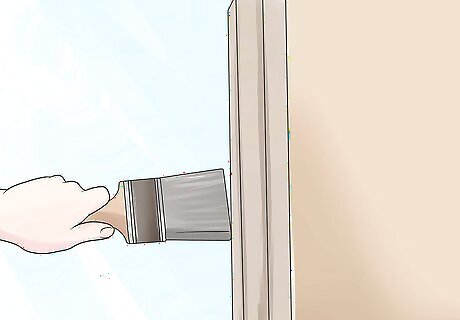
Paint the trim. Once the sidings are complete it's time to go back and paint the trim, whether it's the same color as the rest of the house or not. This is can be quite time-consuming, but will really give your paint job a professional-looking finish. A brush is normally recommended for painting the sidings, as it allows you to be precise however a small 6-inch roller can help to speed up the process, especially on fascia and window sills. As with painting the sidings, you should work on painting the trim from top to bottom - start with any gables and dormers, then do eaves and gutters, then do second-story windows, first-story windows, doors and finally the foundations. When painting the windows, you should protect the glass from paint splatters by covering with masking tape or using a paint shield. Pay special attention to window sills when painting, as these bear the brunt of bad weather and can look more worn than other areas. If necessary give them 2 or 3 coats of paint and don't forget to paint the undersides. It is easier to paint doors if you remove any knobs, knockers and numbers first. Ideally, you should also remove the door from its hinges and lay it flat on the ground before painting, working first on one side, then the other. This will also make it easier to paint the frame and door jambs.




















Comments
0 comment